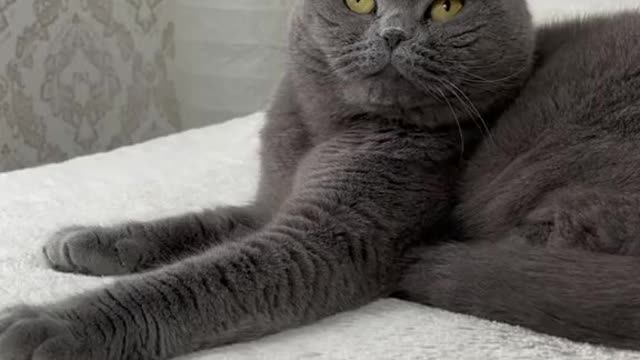Premium Only Content

Cat are playing
A very sneaky somehow manages to scare the stripes off Plasma the cat. It's okay buddy, it won't hurt you!
Among domestic cats, males are more likely to fight than females. Among feral cats, the most common reason for cat fighting is competition between two males to mate with a female. In such cases, most fights are won by the heavier male.Another common reason for fighting in domestic cats is the difficulty of establishing territories within a small home.Female cats also fight over territory or to defend their kittens. Neutering will decrease or eliminate this behavior in many cases, suggesting that the behavior is linked to sex hormones.
When cats become aggressive, they try to make themselves appear larger and more threatening by raising their fur, arching their backs, turning sideways and hissing or spitting. Often, the ears are pointed down and back to avoid damage to the inner ear and potentially listen for any changes behind them while focused forward. They may also vocalize loudly and bare their teeth in an effort to further intimidate their opponent. Fights usually consist of grappling and delivering powerful slaps to the face and body with the forepaws as well as bites. Cats also throw themselves to the ground in a defensive posture to rake their opponent's belly with their powerful hind legs.
Serious damage is rare, as the fights are usually short in duration, with the loser running away with little more than a few scratches to the face and ears. However, fights for mating rights are typically more severe and injuries may include deep puncture wounds and lacerations. Normally, serious injuries from fighting are limited to infections of scratches and bites, though these can occasionally kill cats if untreated. In addition, bites are probably the main route of transmission of feline immunodeficiency virus.Sexually active males are usually involved in many fights during their lives, and often have decidedly battered faces with obvious scars and cuts to their ears and nose.Cats are known for spending considerable amounts of time licking their coats to keep them clean.[113] The cat's tongue has backwards-facing spines about 500 μm long, which are called papillae. These contain keratin which makes them rigid so the papillae act like a hairbrush. Some cats, particularly longhaired cats, occasionally regurgitate hairballs of fur that have collected in their stomachs from grooming. These clumps of fur are usually sausage-shaped and about 2–3 cm (3⁄4–1+1⁄4 in) long. Hairballs can be prevented with remedies that ease elimination of the hair through the gut, as well as regular grooming of the coat with a comb or stiff brush.[113]Domestic cats use many vocalizations for communication, including purring, trilling, hissing, growling/snarling, grunting, and several different forms of meowing.Their body language, including position of ears and tail, relaxation of the whole body, and kneading of the paws, are all indicators of mood. The tail and ears are particularly important social signal mechanisms in cats. A raised tail indicates a friendly greeting, and flattened ears indicates hostility. Tail-raising also indicates the cat's position in the group's social hierarchy, with dominant individuals raising their tails less often than subordinate ones.Feral cats are generally silent.208 Nose-to-nose touching is also a common greeting and may be followed by social grooming, which is solicited by one of the cats raising and tilting its head.
Purring may have developed as an evolutionary advantage as a signaling mechanism of reassurance between mother cats and nursing kittens. Post-nursing cats often purr as a sign of contentment: when being petted, becoming relaxed, or eating. The mechanism by which cats purr is elusive; the cat has no unique anatomical feature that is clearly responsible for the sound.The social behavior of the domestic cat ranges from widely dispersed individuals to feral cat colonies that gather around a food source, based on groups of co-operating females.Within such groups, one cat is usually dominant over the others.Each cat in a colony holds a distinct territory, with sexually active males having the largest territories, which are about 10 times larger than those of female cats and may overlap with several females' territories. These territories are marked by urine spraying, by rubbing objects at head height with secretions from facial glands, and by defecation.Between these territories are neutral areas where cats watch and greet one another without territorial conflicts. Outside these neutral areas, territory holders usually chase away stranger cats, at first by staring, hissing, and growling and, if that does not work, by short but noisy and violent attacks. Despite this colonial organization, cats do not have a social survival strategy or a pack mentality, and always hunt alone.
Life in proximity to humans and other domestic animals has led to a symbiotic social adaptation in cats, and cats may express great affection toward humans or other animals. Ethologically, the human keeper of a cat functions as a sort of surrogate for the cat's mother.Adult cats live their lives in a kind of extended kittenhood, a form of behavioral neoteny. Their high-pitched sounds may mimic the cries of a hungry human infant, making them particularly difficult for humans to ignore.However, some pet cats are poorly socialized. In particular, older cats show aggressiveness towards newly arrived kittens, which include biting and scratching; this type of behavior is known as feline asocial aggression.
Domestic cats' scent rubbing behavior towards humans or other cats is thought to be a feline means for social bonding.
-
 39:07
39:07
Steph & Kayls
5 hours agoFrom Spicy Content to Sleepless Nights: The Chaos of Being First-Time Parents & Creators | Ep. 1
10.8K3 -
 1:36
1:36
Nick Shirley
7 hours ago $1.64 earnedThese Anti-Trump and Elon Protesters are Idiots
17.4K36 -
 17:08
17:08
World2Briggs
1 day ago $0.79 earned10 Worst Cities to Move if You Hate Yourself.
12.4K6 -
 13:32
13:32
megimu32
1 day agoKitKat vs. Twix: One Breaks, One Bites… Who Wins?
16.2K10 -
 24:04
24:04
Link to the Light
19 hours ago $0.27 earnedTop 10 Most Anticipated Games of 2025 - Link to the Light
10.3K3 -
 23:00
23:00
Ohio State Football and Recruiting at Buckeye Huddle
19 hours agoOhio State Football: Spring Game Recap | Biggest Concerns for Buckeyes?
6.66K -
 11:57
11:57
Fit'n Fire
6 hours ago $0.10 earnedGriffin Armament Dual-Lok HRT-762 First Looks
4.71K -
 11:23
11:23
ariellescarcella
1 day agoHere's What Happens To 'Trans Kids' : 15 Year Study Reveals ALL
4.33K16 -
 1:04
1:04
Memology 101
4 hours ago $0.26 earnedOut of touch MULTI-MILLIONAIRE wants YOU paying MORE TAXES to own Trump
3.25K13 -
 13:24
13:24
Talk Nerdy Sports - The Ultimate Sports Betting Podcast
5 hours ago4/13/25 - Sunday Strike Team: Tactical Bets, Brutal Truths, Full Redemption
23.9K3